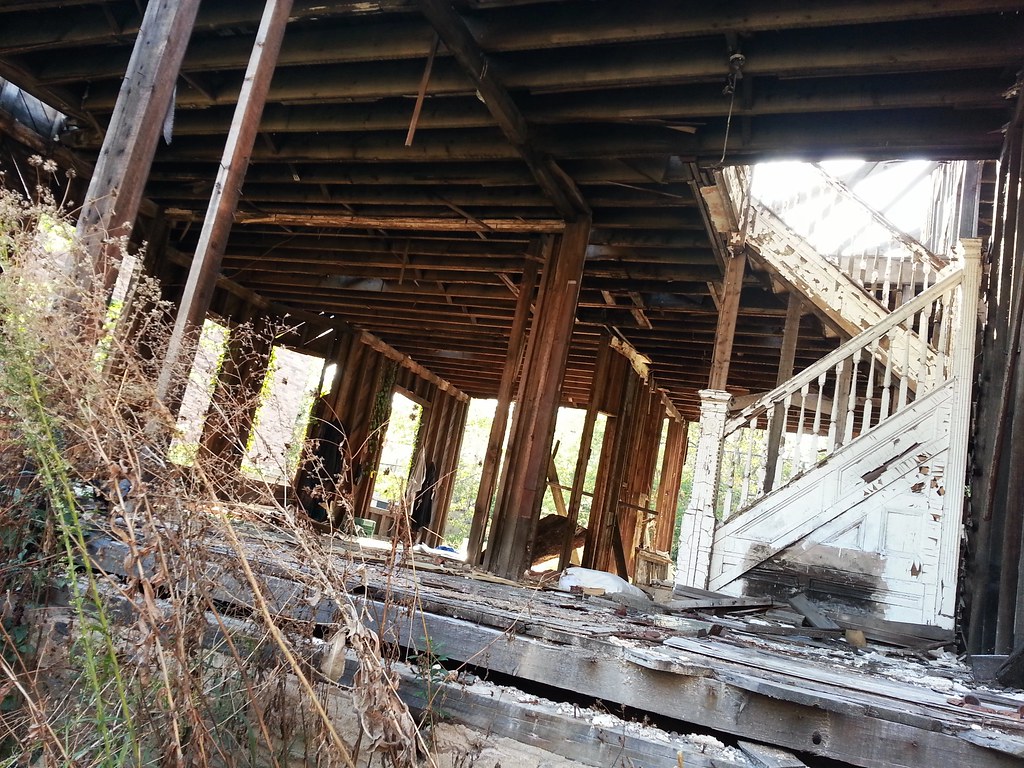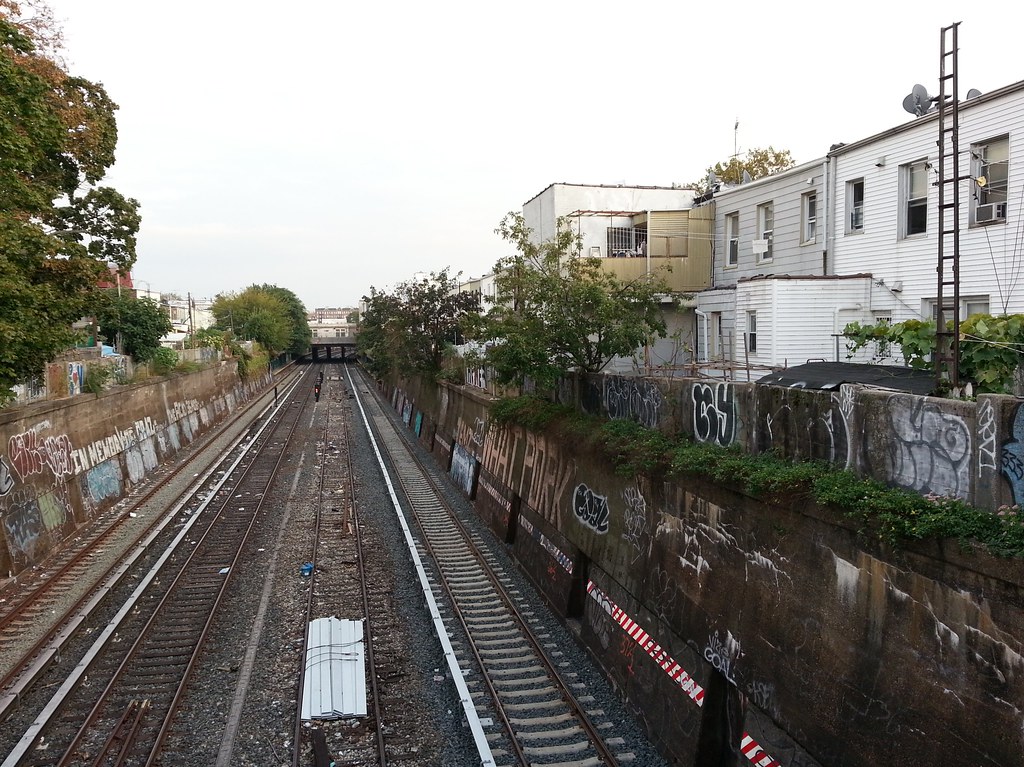

This is the beginning of Prospect Park's totally man-made watercourse, which is mostly fed by a pipe, hidden behind the falls, that connects to the city's water supply system. (In the 19th century, the park's water came from a well; as we saw last year, the old wellhouse is still standing.)

to St. Vincent's Hospital, which closed in 2010. St. Vincent's played a major role in treating those injured on 9/11, and one of its walls was transformed into an impromptu community memorial to victims of the attacks.
(Spotted on an unofficial late-night stroll through Greenwich Village.)

a.k.a. the product display at Bell Fire Extinguisher Co.

on their way to Prospect Park from nearby Kensington Stables

This sculpture and its companion, presumably inspired by the monumental Roman Horse Tamers of antiquity, flank the Park Circle entrance to Prospect Park. According to the Parks Department: "The struggle between the frenzied horses and the nude youth was intended, as the sculpture's original title suggests, to illustrate 'The Triumph of Mind over Brute Force'."

Here are some photos from the much higher-profile version of this event at St. John the Divine.
This park is at the location of the oldest existing milestone in New York City. The New Utrecht Milestone was placed here in approximately 1741 under the reign of George II. The stone, which served as a directional post to travelers, stood at the juncture of two colonial roads: Kings Highway and Old New Utrecht–Flatbush Road (now 18th Avenue). It also served as a gauge to determine postal rates.This property, long owned by the Van Pelts, was deeded to the city for one dollar in 1910 by a family descendant under the "express condition that the said premises be used and maintained as a site for exhibiting and preserving thereon a certain old Dutch milestone." The city has seemingly reneged on this deal, however: the milestone has been removed to the Brooklyn Historical Society. The Parks Department claims that a replica of the stone now stands in the park, but it was nowhere to be seen today.

Another hot spot of multicultural outdoor game-playing in Bensonhurst

This church was established in 1677, and its first church building was put up a few blocks away in 1700 using stones originally brought over as ship ballast from Holland. The current building, above, was constructed in 1828-29 using those same stones from the first church. Just out of frame to the right, still topped by the original eagle and weathervane, is the sixth incarnation of the liberty pole that was erected in 1783 to celebrate the withdrawal of British troops at the end of the Revolutionary War. (84th Street, at its intersection with 16th Avenue adjacent to the church grounds, has been co-named Liberty Pole Boulevard.)

Scott LoBaido's ubiquitous American flag murals have crossed the Narrows and are making some inroads here in Kings County.

At left is a southbound N train on the Sea Beach Line about to pass beneath 19th Avenue. At right, heading south on the northbound-side express (inner) track (as you can see, the express track on the southbound side is no longer usable here), are a bunch of empty new R188 cars, eventually destined to be used on the 7 train, that are likely on their way down to the Coney Island Complex. (It's not the first time such cars have been spotted in the area.)
The Sea Beach express tracks have not been used for regular passenger service in quite some time. All of the station platforms along the line are on the outside of the tracks, so an express train would have nowhere to stop to pick up and drop off riders. When the express tracks were used for passengers decades ago, they provided nonstop service between 59th Street (on the 4th Avenue Line) and the terminal station at Coney Island.

Behind this fence next to a ShopRite grocery store runs the Bay Ridge Branch, an old rail line whose right-of-way carries not only the occasional freight train, but also, as hinted by the signs on the gate, the Buckeye pipeline that transports jet fuel, gasoline, and heating oil to JFK Airport. As you may recall, this pipeline was a target of a highly overblown (here's why) terrorist plot back in 2007.

Staten Island Tea Party favorite Scott LoBaido decided to add some bite to one of his innumerable American flag murals (most are in Staten Island; this is the second we've seen in Brooklyn) after someone defaced it with the message "Patriotism Makes Me Sick", an act that LoBaido described as a "hate crime".

This event space and lounge, with its pagan-inspired artwork, is housed inside the former Talmud Torah Beth Jacob Joseph synagogue. A closer look reveals many traces of the building's past.

According to the AIA Guide to New York City, this "dour red-painted institutional remnant" (I guess the red has faded to pink since that was written) was erected around 1840 as the Brooklyn Boys' Boarding School, and later became Public School 15. I think the 1840 date might only apply to the portion of the structure with the peaked roof here on the corner of State Street and 3rd Avenue; as you pass down the block to the left, toward Schermerhorn Street, you encounter three architecturally distinct sections. The taller part of the building at far left, which the NY Times says was once a Civil War infirmary, now houses the relocated Khalil Gibran International Academy, as well as the final senior class of the failed Metropolitan Corporate Academy, while the rest of the complex, as far as I can tell, serves as office space for the city's Board of Education.
(That's the Williamsburgh Savings Bank Tower looming in the rear.)

It wasn't apparent when I passed by on 3rd Avenue last year, but this former Daily News garage is now a giant rock-climbing gym.

The fleshy red arils surrounding the toxic seeds are the only non-poisonous parts of the plant, but I still wouldn't recommend eating them.

This Venetian palace was built in 1889-91 for the once-prominent Montauk Club. After struggling financially during the latter part of the 20th century, the club sold the upper two floors to a developer, who converted them into condos (pictures here).

"Fifty years later . . . there is little to indicate that the corner of Seventh Avenue and Sterling Place in Park Slope, Brooklyn, bore violent witness to the worst air disaster at the time, that the disembodied leviathan tail of a ruined jet came to rest here amid flaming carnage and falling brick."
That quote is from a 2010 NY Times City Room post that goes on to describe some of the remaining signs — the "faded scars" — of what is commonly known as the Park Slope plane crash, a 1960 mid-air collision of two airliners that sent one hurtling into Park Slope and the other into Miller Army Airfield in Staten Island, killing all 128 people aboard, as well as 6 people on the ground in Park Slope. Several buildings were damaged or destroyed, but the old Lillian Ward House, above, survived intact.
(You can check out the Times's full semi-centennial City Room coverage of the disaster here.)

This long-vacant house got a radical new paint job last summer.






























